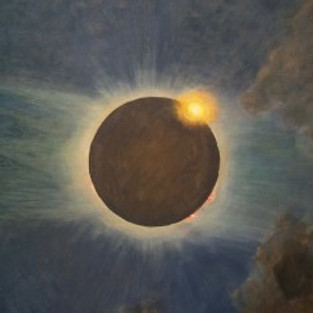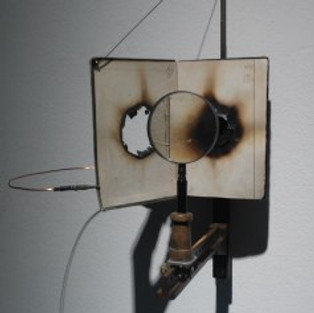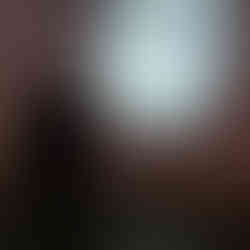
Film still from: Opening Scene of “Werckmeister Harmonies” 2001 by Bela Tarr Photo Credit Larry Gipe
“Eclipse” at Art Center College of Art and Design, Pasadena, CA
On view through September 10th
By Larry Gipe
On May 29, 1919, the sun’s corona burst out from around the dark disc of the moon in a total eclipse. Before this moment countless humans had experienced this spectacle with varying degrees of superstition, fear and wonder. But, on this occasion, scientists trained their instruments on the event to confirm the most groundbreaking concept in modern science: Einstein’s General theory of relativity. Using the background stars of Taurus as their guide, they were able to confirm what Einstein had suspected but couldn’t prove without an eclipse: that light itself could be deflected by the sun’s massive gravitational pull.
Einstein was particularly relieved, as this was the second (expensive) attempt to monitor an eclipse for the crucial data he needed. On June 8, 1918, a U.S.-based alliance of physicists in Oregon got a grant to study the phenomenon, with a special experiment dedicated to Einstein’s proposition (this was, in fact, the last time the path of a total eclipse passed over the United States before today’s occurrence). Unfortunately, at the time of totality, this “first try” was ruined when a thin veil of cirrus clouds blocked the sun, and the expedition failed to make the precise observations needed to confirm the theory.
They didn’t leave completely empty-handed. One of the physicists involved, Howard Russell Butler (1856-1934), was also an artist and was charged with the task of creating a color rendering of the eclipse. He was able to take enough notes during the 112 seconds of totality to make a triptych oil painting of the experience. The result – while not interesting science – is a charming interpretation; it is the first artwork one sees at the entrance to “Eclipse”, a fascinating and layered exhibition co-curated by Williamson Gallery director Stephen Nowlin and Williams College astronomer Jay Pasachoff at Art Center School of Art and Design’s Alyce de Roulet Williamson Gallery. The historical paintings by Dr. Butler are joined by a perfectly chosen group of contemporary artists including Lita Albuquerque, Russell Crotty, Stephen Dankner, Rosemarie Fiore, Michael C. McMillen and Jacqueline Woods. Nowlin blends in the new work with astronomical artifacts from the Lick Observatory and Carnegie Observatories, Goddard Space Flight Center, artifacts from the Huntington Library, and projections from NASA sources.
According to NASA, there are ongoing experiments during the trajectory of today’s event, but none of them are in the “ground-breaking” category. It seems that, unless you’re driving up to Oregon to get the whole sensory trip, an eclipse in this day and age is mainly about historical reflection and curiosity. To this end, Nowlin fashions an experience that appeals to the visual, poetic and analytical sides of our collective natures, and he keeps the show: “in the context of real science, not new ageism or pseudoscience”, seeing to engage the “symbolism, emotional reactions and the aesthetics” of a total eclipse.

Russell Crotty “Blue Totality” 2017 Ink and watercolor, fiberglass, plastic and tinted bio-resin on paper. Photo Credit Larry Gipe
He is aided appropriately by the work chosen, including a new piece by Russell Crotty, the most “shoe-in” artist of the exhibition. Crotty’s career has often incorporated his keen interest in astronomy, and he makes observations as an established amateur practitioner from a mini-observatory with a 10-inch reflector telescope. In the early-90’s, Crotty started a series of marvelous “globe drawings” that evinced his obsession with the patterns and complexities of the night sky. Fabricating fiberglass globes – some up to 72” in diameter – Crotty coated them with paper and executed delicate renderings of the Milky Way, globular clusters, and other astronomical subjects in graphite on the surface. While it would’ve been preferable to have one of these marvels floating in the show, Crotty’s entry “Blue Totality” (2017), was clearly made freshly for “Eclipse”. Similar to works in his last solo at Shoshana Wayne Gallery, “Blue Totality” starts with an ink/watercolor drawing, which Crotty submerges in “bio-resin”, an organic, toxic-neutral substance that encases the contents; the result blurs the line between sculpture and drawing – as Crotty’s work is wont to do.

Lita Albuquerque “Eclipse,” 2017. Looping video, 11m-56sec. Object, gold-plated bronze. Sound: Sussan Deyhim. Editing: Marc Breslin. Courtesy of the artist. Photo: Juan Posada/ArtCenter
Lita Albuquerque gets the most real estate, with a room dedicated to a sculpture and large-scale projected video. While this installation generates a fine sense of mystery and ambiance, viewers might find their mood distracted by the text in the video, which feels jarringly literal in this context. Other galleries blend the scientific and aesthetic, and Nowlin’s choice of using NASA projections with a clip from Bela Tarr’s 2001 film “Werckmeister Harmonies,” is one of the most satisfactory collocations. The projections include a Moon in “first quarter” phase, the Earth, and an infrared photo of the Sun that reveals it as a fiery, nuclear furnace. Spectators are invited to sit and activate a small monitor on wall four, which plays the opening of Tarr’s Hungarian film set in the Soviet era. The clip takes place in a bar, and as the scene begins, it’s clear that the patrons have accomplished staggering amounts of drinking. Before the party breaks up, the youngest reveler is encouraged to perform a story. In this completely beguiling sequence, the charismatic entertainer employs his intoxicated mates as living props. Designating one as the Sun, others as the moon and Earth, he sets them stumbling and spinning in a choreographic simulation of the solar system during an eclipse.

Rosemarie Fiore “Smoke Eclipse #52” 2015 Firework smoke residue on Sunray paper. On loan from Von Lintel Gallery Photo Credit Larry Gipe
Nowlin rounds out the show with work by Rosemarie Fiore and Jacqueline Woods, both of who use the motif of the disc in their beautiful abstract compositions. Michael C. McMillen provides one small sculpture that makes for an apt coda. Called “Burn”, it’s a somewhat sinister-looking wall apparatus consisting of an open book and a magnifying glass – which has burned a corresponding charred pit into the pages of the volume. Need this author warn you? Without the proper eclipse ear wear, your optic nerve will end up in similar condition. So, enjoy the event today (coming to Los Angeles skies at 10:21 a.m.), and view it safely.
#losangeles #california #losangelesartist #einstein #art #painting #pasadena #HowardRussellButler #losangelesart #hollywood #contemporaryart #southerncalifornia #eclipse #abstract #collage #artcentercollegeofartanddesign #includingLitaAlbuquerque #photography #artgallery #RussellCrotty #gallery #culvercity #museum #theoryorrelativity #MichaelCMcMillen #artandcake #artopening #JayPasachoff #assemblage #artexhibition #installation #ArtandCakeLA #fineart #artists #artist #soloshow #mixedmedia #arts #environment #sculpture #ArtandCulture #exhibition #StephenNowlin #RosemarieFiore #graphite #exhibit #WilliamsCollege #StephenDankner #dtla #JacquelineWoods #drawing






